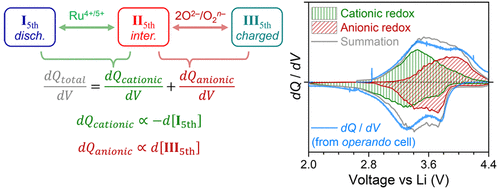当前位置:
X-MOL 学术
›
Chem. Mater.
›
论文详情
Our official English website, www.x-mol.net, welcomes your
feedback! (Note: you will need to create a separate account there.)
Decoupling Cationic–Anionic Redox Processes in a Model Li-Rich Cathode via Operando X-ray Absorption Spectroscopy
Chemistry of Materials ( IF 7.2 ) Pub Date : 2017-11-16 00:00:00 , DOI: 10.1021/acs.chemmater.7b03434 Gaurav Assat 1, 2, 3 , Antonella Iadecola 2 , Charles Delacourt 2, 4 , Rémi Dedryvère 2, 5 , Jean-Marie Tarascon 1, 2, 3
Chemistry of Materials ( IF 7.2 ) Pub Date : 2017-11-16 00:00:00 , DOI: 10.1021/acs.chemmater.7b03434 Gaurav Assat 1, 2, 3 , Antonella Iadecola 2 , Charles Delacourt 2, 4 , Rémi Dedryvère 2, 5 , Jean-Marie Tarascon 1, 2, 3
Affiliation

|
The demonstration of reversible anionic redox in Li-rich layered oxides has revitalized the search for higher energy battery cathodes. To advance the fundamentals of this promising mechanism, we investigate herein the cationic–anionic redox processes in Li2Ru0.75Sn0.25O3—a model Li-rich layered cathode in which Ru (cationic) and O (anionic) are the only redox-active sites. We reveal its charge compensation mechanism and local structural evolutions by applying operando (and complementary ex situ) X-ray absorption spectroscopy (XAS). Among other local effects, the anionic-oxidation-driven distortion of the oxygen network around Ru atoms is thereby visualized. Oxidation of lattice oxygen is also directly proven via hard X-ray photoelectron spectroscopy (HAXPES). Furthermore, we demonstrate a spectroscopy-driven visualization of electrochemical reaction paths, which enabled us to neatly decouple the individual cationic–anionic dQ/dV contributions during cycling. We hence establish the redox and structural origins of all dQ/dV features and demonstrate the vital role of anionic redox in hysteresis and kinetics. These fundamental insights about Li-rich systems are crucial for improving the existing anionic-redox-based cathodes and evaluating the ones being discovered rapidly.
中文翻译:

通过Operando X射线吸收光谱法分析富锂模型中的阳离子-阴离子氧化还原过程
富锂层状氧化物中可逆阴离子氧化还原的演示使寻找更高能量的电池阴极的努力得以复兴。为了推进这一有前途的机制的基础,我们在这里研究Li 2 Ru 0.75 Sn 0.25 O 3中的阳离子-阴离子氧化还原过程-一种富模型的层状阴极,其中Ru(阳离子)和O(阴离子)是唯一的氧化还原活动站点。我们通过应用操作(以及非原位补充)来揭示其电荷补偿机制和局部结构演化X射线吸收光谱(XAS)。在其他局部效应中,可以看到Ru原子周围氧网络的阴离子氧化驱动变形。晶格氧的氧化也可以通过硬X射线光电子能谱(HAXPES)直接证明。此外,我们展示了光谱驱动的可视化电化学反应路径,使我们能够在循环过程中将各个阳离子-阴离子dQ / dV的贡献整齐地解耦。因此,我们建立了所有dQ / dV的氧化还原和结构起源的特点,并证明了阴离子氧化还原在磁滞和动力学中的重要作用。这些有关富锂系统的基本见解对于改进现有的基于阴离子-氧化还原的阴极并评估迅速发现的阴极至关重要。
更新日期:2017-11-16
中文翻译:

通过Operando X射线吸收光谱法分析富锂模型中的阳离子-阴离子氧化还原过程
富锂层状氧化物中可逆阴离子氧化还原的演示使寻找更高能量的电池阴极的努力得以复兴。为了推进这一有前途的机制的基础,我们在这里研究Li 2 Ru 0.75 Sn 0.25 O 3中的阳离子-阴离子氧化还原过程-一种富模型的层状阴极,其中Ru(阳离子)和O(阴离子)是唯一的氧化还原活动站点。我们通过应用操作(以及非原位补充)来揭示其电荷补偿机制和局部结构演化X射线吸收光谱(XAS)。在其他局部效应中,可以看到Ru原子周围氧网络的阴离子氧化驱动变形。晶格氧的氧化也可以通过硬X射线光电子能谱(HAXPES)直接证明。此外,我们展示了光谱驱动的可视化电化学反应路径,使我们能够在循环过程中将各个阳离子-阴离子dQ / dV的贡献整齐地解耦。因此,我们建立了所有dQ / dV的氧化还原和结构起源的特点,并证明了阴离子氧化还原在磁滞和动力学中的重要作用。这些有关富锂系统的基本见解对于改进现有的基于阴离子-氧化还原的阴极并评估迅速发现的阴极至关重要。











































 京公网安备 11010802027423号
京公网安备 11010802027423号